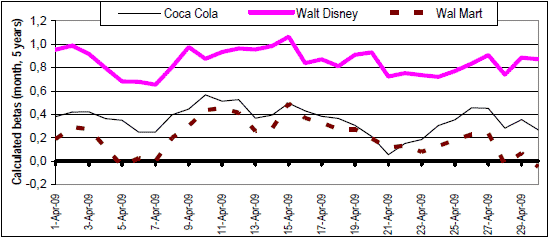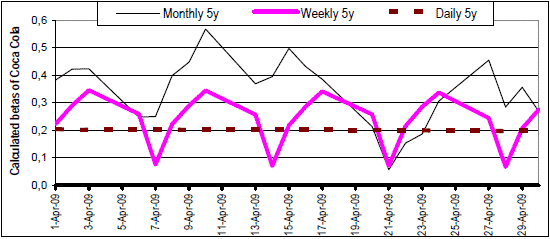Is beta a useful risk management or leveraging tool for investors? Two May 2009 articles, “Beta = 1 Does a Better Job than Calculated Betas” by Pablo Fernandez and Vicente Bermejo and “Betas Used by Professors: A Survey with 2,500 Answers” by Pablo Fernandez, address this question by testing the reliability of beta measurements over time, across calculation methods and across data sources. Focusing on betas for the Dow Jones industrial stocks relative to the S&P 500 index, these articles conclude that:
- Different sources provide very different values of beta. For example, values of beta as of May 12, 2009 from sources frequently cited by finance and economics professors in survey responses vary from:
- 0.31 to 0.80 for Coca Cola
- 0.72 to 1.39 for Walt Disney
- 0.13 to 0.71 for Wal-Mart
- Betas calculated from historical data based on a “standard” method vary considerably on a daily basis (see the first chart below).
- Betas calculated from historical data vary considerably with the length of the historical interval (e.g., three years or five years), frequency of return measurement (e.g., monthly or weekly or daily) and reference index used (see the second chart below).
- Even when constrained to a specific calculation method, betas for different stocks can vary considerably with respect to each other. One cannot consistently determine with confidence that the beta for one stock is higher than the beta for another.
- Over the period 1989-2008, a constant beta=1 generally yields higher correlations of individual stock returns with S&P 500 index returns than do unique stock betas calculated from historical data for all but two of the Dow Jones industrial stocks.
- Beta does not consistently relate to other measures of risk.
The following chart, taken from the paper, plots the betas for Coca Cola, Walt Disney and Wal-Mart for each trading day of April 2009 with respect to the S&P 500 index based on five years of monthly data. It shows that beta calculated via this “standard” method can vary considerably over very short periods.

The next chart, also from the paper, plots the betas for Coca Cola for each trading day of April 2009 with respect to the S&P 500 index based on five years of monthly, weekly and daily data. It shows that betas calculated with different return frequencies have very different values and variabilities.

In summary, stock betas calculated from historical data vary considerably over short intervals, across calculation methods and across data sources and therefore may be of little or no value as an investment tool.